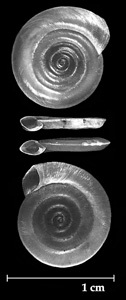Genus: ANISUS Studer, 1820
Rather like a small Planorbis, except that the whorls are not keeled, although in some species the periphery is bluntly angled or even sharply shouldered.

Anisus leucostoma
(Millet, 1813)
Anisus leucostoma (Millet, 1813)
Description: The shell is slightly glossy and rather thick, with close transverse striae, and is of a light horn colour. It has 6 – 6½ rounded whorls which are evenly arranged in one plane, although the spire may be depressed and the lower surface rather concave. The periphery is generally only slightly shouldered above. There is sometimes a white rib around the inside of the mouth aperture, which is rounded, not oval.
Size: Height 1.5 mm. Breadth: 5 – 7 mm.
Habitat: It is commonly found in streams and ditches which dry out in summer, and in marshes all over Britain, although it becomes less frequent further north, and is recorded from only scattered localities in Ireland.
ANDERSON R. 2008 An annotated list of the non-marine Mollusca of Britain and Ireland (available here).
FALKNER G., BANK R.A., & VON PROSCHWITZ T. 2001 Checklist of the non-marine Molluscan Species-group taxa of the States of Northern, Atlantic and Central Europe (CLECOM 1) Heldia 4: 1-76.
GLÖER P. 2002 Mollusca 1. Die Süsswassergastropoden Nord und Mitteleuropas, Bestimmung-schlüssel, Lebenweise, Verbreitung, Die Tierwelt Deutschlands Begründet 1925 von Friedrich Dahl. 73 Teil. Conchbooks, Hackenheim. 327pp.

Anisus vortex
(Linnaeus, 1758)
Anisus vortex (Linnaeus, 1758)
Description: The shell is thin and glossy, although it frequently bears a light deposit which hides the gloss. It has 6 – 8 whorls and bears very delicate striations. It is horn coloured. The most obvious feature is the prominent angulation towards the upper side of the periphery, to such an extent that the top surface gives the appearance of having been planed off, but it is well rounded below. The aperture is somewhat rhomboidal in shape because of this. The shell occasionally appears bent, due to the coils not being entirely in one plane.
Size: Height 1.5 – 2 mm. Breadth: 8 – 10 mm.
Habitat: Frequent in streams, rivers, canals, ponds and ditches, where there is a plentiful growth of water weeds. It is sometimes found in marshes on plants out of the water.

Anisus vorticulus
(Troschel, 1834)
Anisus vorticulus (Troschel, 1834)
Description: This shell differs from A. vortex mainly by being smaller, very thin and rather brittle. It has 5 – 6 whorls. It is light yellowish-horn coloured, glossy and smooth, although it also sometimes bears an encrusting deposit. The periphery bears a sharp and prominent angulation at about the mid-line. This gives the aperture a distinctly oval shape, and it is set more obliquely against the body whorl. The sutures are deeper, so that it appears concave on both sides. Like A. vortex, it also may appear bent due to the coils not being entirely in one plane.
Size: Height: 1 mm. Breadth: 4 – 7 mm.
Habitat: This is a very rare snail, being found only in the mollusc rich waters of some good quality, well vegetated marsh drains in Norfolk and Sussex, where it is confined to the grassy edges of the drains. It is not found in the deeper water. It only occurs in low densities even where it is found.
